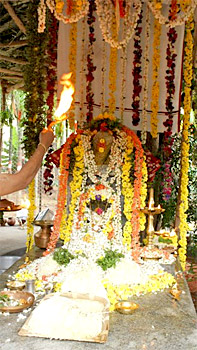 There is a peculiar custom among the Hindus and this can be named as Naga Pratishta. It consists in the establishment of Naga or snake images made out of stone under the spreading branches of Asvatta tree on the banks of the village tank. They established it with the enjoined religious rites and ceremonies. Generally barren women observe this custom of Naga-Pratishta and circumambulate the sacred Asvatta tree to shake off their sterile curse and be blessed with offsprings. At least in many of the cases it is Strange to see that people who observe this custom are successful in getting their wishes gratified. Else this custom could not have withstood the onslaught of the materialistic waves of centuries.
There is a peculiar custom among the Hindus and this can be named as Naga Pratishta. It consists in the establishment of Naga or snake images made out of stone under the spreading branches of Asvatta tree on the banks of the village tank. They established it with the enjoined religious rites and ceremonies. Generally barren women observe this custom of Naga-Pratishta and circumambulate the sacred Asvatta tree to shake off their sterile curse and be blessed with offsprings. At least in many of the cases it is Strange to see that people who observe this custom are successful in getting their wishes gratified. Else this custom could not have withstood the onslaught of the materialistic waves of centuries.
In most of the cases women of soft constitution are liable to be barren. Indian women do not have the benefit of outdoor exercises except when they go round on annual tours of pilgrimage. So some sort of exercise is of absolute necessity for them to shake off their barrenness. Generally women belonging to the working classes have many children born to them whereas those belonging to the richer classes are barren and if at all they bring forth issues, they are few and not enough strong as compared to the children of the working classes.
The wise preceptors of the rich people in bygone days wanted to give the rich ladies some sort of exercise coupled with a mental attitude favourable for child-bearing. Religious belief was pressed into service. The ancient Aryans worshipped nature by worshipping certain animals having special characteristics of the elements. They desired to worship and as the serpent happened to symbolize wisdom and the one commonly considered sacred and hence greatly venerated. It was selected as the fittest object to inspire veneration in women. As the living serpent was not a safe object to be kept near, stone image of one took its place. According to the scientists, the mental attitude is an essential thing for a woman to conceive and give birth to a healthy child. The serpent, symbolical of the highest form of wisdom, should create a wise mental attitude in the mind of the woman to give birth to a worthy issue.
There is one specific reason why it was located under a tree and that too the sacred Asvatta tree. And the reason can be stated as it is a tree that is royal in appearance to inspire veneration in human beings and further it affords a pleasant shade because of its spreading foliage on the cool banks of the village tank or river. From a medical point of view, the Hindu physicians considered the sacred tree Asvatta to possess miraculous virtues and medicinal properties. They believe that if consequently any male or female remained in its vicinity he or she would surely be the better for it.
The reason why the image was not placed inside the house and worshipped is mainly because of the fear that `Familiarity May Breed Contempt.` The second reason is that the open air on the banks of tanks and rivers is more favourable to recoup health and vitality. Whereas the confined atmosphere of a house would only make them more sickly if they took exercise of the nature intended by the then wise that they should take.
The reason why barren ladies generally throw off their barrenness and become enceinte is that they take a good exercise in the exhilarating early hours of the morning. They usually dwell upon the one thought that she should conceive and bring forth a child. These are the necessary things, namely, a healthy body that is furnished by the circum-ambulation of the Naga image or images under the sacred tree and also a mind congenial and favourable to become enceinte. After all perhaps there is no miracle performed here but only favourable conditions created by nature to affect its purpose.




















